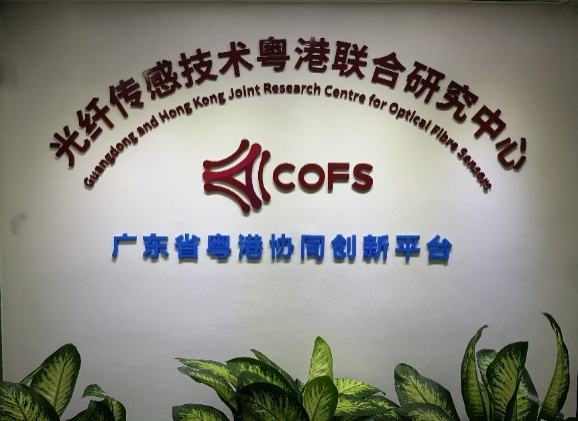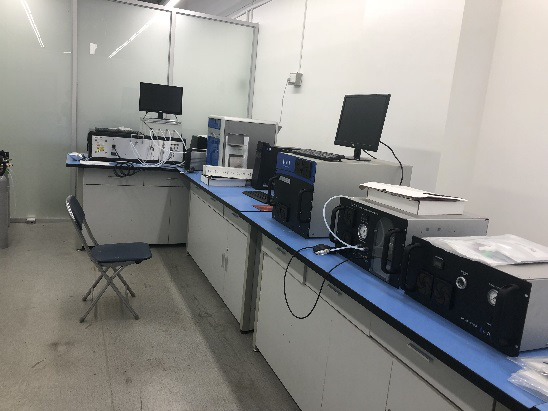The college currently has 17 provincial and municipal-level key laboratories—Key Laboratory of Optoelectronic Devices and Systems (Shenzhen University), Ministry of Education, Key Laboratory of Optoelectronic Devices and Systems Guangdong Province, Guangdong and Hong Kong Joint Research Center for Optical Fiber Sensors, Guangdong Provincial Engineering Research Center for Breathtest Technology, Shenzhen Key Laboratory of Laser Engineering, Shenzhen Key Laboratory of Micro-nano Photonic Information Technology, Shenzhen Key Laboratory of Optical Fiber Sensors, Shenzhen Key Laboratory of High-Purity Germanium Materials and Detector Manufacturing, Shenzhen Optical Fiber Sensing Network Technology Engineering Laboratory, Shenzhen Key Laboratory of Biomedical Optical Micro-nano Detection and Imaging, Shenzhen Key Laboratory of Internet of Things Photonic Devices and Sensing Systems, Shenzhen Engineering Laboratory of Optical Materials Femtosecond Laser Fabrication Technology, Shenzhen Key Laboratory of Advanced Thin Films and Applications, Shenzhen Key Laboratory of Intelligent Optical Measurement and Detection, Shenzhen Key Laboratory of Photonics and Biophotonics, Shenzhen Key Laboratory of Ultrafast Laser Micro-nano Manufacturing, Shenzhen Key Laboratory of Nuclear and Radiation Safety.
Key Laboratory of Optoelectronic Devices and Systems Shenzhen University & Ministry of Education
Key Laboratory of Optoelectronic Devices and Systems Guangdong Province
The Key Laboratory was approved for establishment in December 2002 under the leadership of the renowned optoelectronics expert and Academician of the Chinese Academy of Engineering, Niu Hanben. It passed the Guangdong Provincial evaluation in November 2005 and the Ministry of Education evaluation in December 2007, becoming a jointly built key laboratory by both the Ministry of Education and Guangdong Province. The development of the Key Laboratory has been recognized by both the Ministry of Education and Guangdong Province. In 2022, the “Key Laboratory of Optoelectronic Devices and Systems, Shenzhen University & Ministry of Education” received an excellent rating in the Ministry of Education’s evaluation of key laboratories, marking the first time in 20 years since its establishment that it was rated excellent. Additionally, the Key Laboratory also received an excellent rating in the 2022 Guangdong provincial key laboratory evaluation.
The Key Laboratory emphasizes cutting-edge global technologies and the health and well-being of the people. It conducts fundamental scientific research on common issues and key technologies in optoelectronic devices and systems, and is committed to cultivating and gathering a large number of high-level talents dedicated to both basic and applied research. The laboratory has fostered significant international and domestic scientific cooperation and exchange, resulting in numerous original research achievements.Currently, the Key Laboratory aligns with the development trends of optical engineering disciplines and the country's major strategic goals. It leverages three first-level doctoral programs and postdoctoral research stations in Optical Engineering, Physics, and Electronic Information to conduct in-depth research on common scientific problems and key technologies in optoelectronic devices and systems. Based on this foundation, the laboratory has developed five main research directions: intelligent optical measurement and imaging technologies, biomedical optics and photonics, optical fiber sensing and laser technologies, integrated photonics and functional materials, and transient optics and optoelectronics.The laboratory has established itself as a strong research and talent cultivation base in optoelectronics with distinct characteristics, actively advancing both fundamental theory and applied research in these fields.
With the support and driving force of the Key Laboratory, a number of provincial and municipal-level research institutions have been established, including the Guangdong and Hong Kong Joint Research Center for Optical Fiber Sensors, Shenzhen Key Laboratory for Ultrafast Laser Micro-Nano Manufacturing, Shenzhen Key Laboratory of Intelligent Optical Measurement and Detection, Shenzhen Key Laboratory for IoT Photonic Devices and Sensing Systems, Shenzhen Key Laboratory for Biomedical Optical Micro-Nano Detection and Imaging, Shenzhen Key Laboratory for Laser Engineering, Shenzhen Key Laboratory for Micro-Nano Photonic Information Technology, Shenzhen Key Laboratory of Advanced Thin Films and Applications, and the Shenzhen Engineering Laboratory for Femtosecond Laser Fabrication of Optical Materials, among others. These have significantly enriched and strengthened the research capabilities of the Key Laboratory. Through long-term research, the Key Laboratory has developed distinct features and has made a significant impact in related international academic fields. The research directions of the Key Laboratory are closely aligned with the development of the dominant industries in the Greater Bay Area, playing a major role in driving the national economy and social development of Shenzhen.
Currently, the Key Laboratory has formed a research team with a reasonable age structure and international influence, led by an academician of the Chinese Academy of Sciences (CAS) as the academic leader, with core members including National Distinguished Young Scholars, national-level leading scholars, and academic backbones such as National Excellent Young Scholars, Youth Experts of the Organization Department, and provincial and municipal-level talents. The laboratory has 145 full-time staff members, including 41 senior professors, 43 associate professors, and 40% of the research team is under 40 years old. The team includes 13 nationally recognized talents, including 1 academician of the Chinese Academy of Sciences, 3 National Distinguished Young Scholars, 4 National Excellent Young Scholars, and 4 other national-level talents.
In the past five years, the laboratory has trained 5 national-level talents, including 1 National Distinguished Young Scholar (Liu Liwei), and 3 National Excellent Young Scholars (Weng Xiaoyu, Liao Changrui, He Jun). Over the past five years, laboratory members have led 434 research projects, including National Key R&.D Programs, National Major Scientific Instrument Development Projects, National Natural Science Foundation (NSFC) Key Projects, National Distinguished/Excellent Young Scholars Projects, and International Cooperation Projects (190 national-level projects, 64 provincial and ministerial-level projects, 94 municipal-level projects, and 86 horizontal cooperation projects). The total research funding is 390 million RMB.
The laboratory has published 571 SCI papers in journals such as Nature Communications, Light: Science & Applications, Advanced Materials, and Physical Review Letters. It has been granted 192 Chinese invention patents and 23 international invention patents. The laboratory has also won 15 scientific and technological awards, including the First Prize of the Military Science and Technology Progress Award, the Second Prize of the China Optical Society Science and Technology Award, the Second Prize of Guangdong Province Science and Technology Progress Award, and the Second Prize of Shenzhen Natural Science Award.


Guangdong and Hong Kong Joint Research Center for Optical Fiber Sensors
Guangdong and Hong Kong Joint Research Center for Optical Fiber Sensors was established in 2015 with approval from the Guangdong Provincial Department of Science and Technology as a Guangdong-Hong Kong collaborative innovation platform. The team consists of 101 members, including 1 Chair Professor, 3 Distinguished Professors, 4 Associate Professors, 3 Assistant Professors, 9 Full-time Researchers, 7 Postdoctoral Researchers, 20 PhD students, and 53 Master’s students.
The research center has a laboratory area of 1,000 square meters and equipment valued at 120 million yuan. Its main focus is on fiber optic sensing technology research, specializing in applied basic research on new fiber optic sensing devices and systems. The center primarily conducts research on the fabrication technology of fiber optic microstructured devices, fiber optic sensing technology for extreme environments, and the mechanisms, methods, and applications of fiber optic sensing technology in health and life sciences.
The research center’s members have been selected for various talent programs a total of 35 times, including 16 instances in national programs such as the National Outstanding Youth (NSFC), National Youth Talent Program, and National Young Experts (overseas) program, 5 instances in provincial programs such as Guangdong Provincial Outstanding Youth, and 14 instances in municipal programs such as Shenzhen City Excellent Young Scientists. The center’s members have received several prestigious awards, including the second prize of the Ministry of Education Natural Science Award, the first prize of the Guangdong Optical Society Optical Science and Technology Award, and the first prize of the Shenzhen City Natural Science Award.
The research center has initiated 198 research projects (56 national-level projects, 55 provincial and ministerial-level projects, 48 municipal-level projects, 15 industry collaborations, and 24 talent-driven projects) with a total funding of 233 million yuan. It holds 49 authorized international and domestic invention patents and 85 utility model patents.
The center has published 312 journal articles (291 SCI papers, 74 in Q1 journals, 148 in Q2 journals), 307 conference papers (5 invited plenary talks, 134 invited talks), and 4 book chapters. It has organized 22 academic conferences. Additionally, 197 graduate students have participated in international and domestic academic conferences, with 84 delivering oral presentations.
Graduate students of the research center have won numerous awards, including the National Outstanding Doctoral Dissertation Award in Optical Engineering, National Scholarships, and Guangdong Province Excellent Student Awards, with a total of 110 awards. In the past five years, the center’s graduate students have won 65 awards, including the Wang Daheng Optics Prize (Student Award).
In the past five years, the research center has organized academic conferences such as the “5th Guangdong Photonics and Technology Collaborative Innovation Forum” and the “Micro-Nano Photonics and Fiber Optic Sensing Technology Frontier Symposium.” It has also engaged in academic exchanges with experts and scholars from organizations like China General Nuclear Power Group, China National Offshore Oil Corporation, Huawei, China National Nuclear Corporation, and Hengtong Ocean.



Guangdong and Hong Kong Joint Research Center for Optical Fiber Sensors
Guangdong and Hong Kong Joint Research Center for Optical Fiber Sensors was established in 2015 with approval from the Guangdong Provincial Department of Science and Technology as a Guangdong-Hong Kong collaborative innovation platform. The team consists of 101 members, including 1 Chair Professor, 3 Distinguished Professors, 4 Associate Professors, 3 Assistant Professors, 9 Full-time Researchers, 7 Postdoctoral Researchers, 20 PhD students, and 53 Master’s students.
The research center has a laboratory area of 1,000 square meters and equipment valued at 120 million yuan. Its main focus is on fiber optic sensing technology research, specializing in applied basic research on new fiber optic sensing devices and systems. The center primarily conducts research on the fabrication technology of fiber optic microstructured devices, fiber optic sensing technology for extreme environments, and the mechanisms, methods, and applications of fiber optic sensing technology in health and life sciences.
The research center’s members have been selected for various talent programs a total of 35 times, including 16 instances in national programs such as the National Outstanding Youth (NSFC), National Youth Talent Program, and National Young Experts (overseas) program, 5 instances in provincial programs such as Guangdong Provincial Outstanding Youth, and 14 instances in municipal programs such as Shenzhen City Excellent Young Scientists. The center’s members have received several prestigious awards, including the second prize of the Ministry of Education Natural Science Award, the first prize of the Guangdong Optical Society Optical Science and Technology Award, and the first prize of the Shenzhen City Natural Science Award.
The research center has initiated 198 research projects (56 national-level projects, 55 provincial and ministerial-level projects, 48 municipal-level projects, 15 industry collaborations, and 24 talent-driven projects) with a total funding of 233 million yuan. It holds 49 authorized international and domestic invention patents and 85 utility model patents.
The center has published 312 journal articles (291 SCI papers, 74 in Q1 journals, 148 in Q2 journals), 307 conference papers (5 invited plenary talks, 134 invited talks), and 4 book chapters. It has organized 22 academic conferences. Additionally, 197 graduate students have participated in international and domestic academic conferences, with 84 delivering oral presentations.
Graduate students of the research center have won numerous awards, including the National Outstanding Doctoral Dissertation Award in Optical Engineering, National Scholarships, and Guangdong Province Excellent Student Awards, with a total of 110 awards. In the past five years, the center’s graduate students have won 65 awards, including the Wang Daheng Optics Prize (Student Award).
In the past five years, the research center has organized academic conferences such as the “5th Guangdong Photonics and Technology Collaborative Innovation Forum” and the “Micro-Nano Photonics and Fiber Optic Sensing Technology Frontier Symposium.” It has also engaged in academic exchanges with experts and scholars from organizations like China General Nuclear Power Group, China National Offshore Oil Corporation, Huawei, China National Nuclear Corporation, and Hengtong Ocean.
The Guangdong Province Breathtest Engineering Technology Research Center
The Guangdong Province Breathtest Engineering Technology Research Center was established in September 2017 and recognized by the Guangdong Provincial Department of Science and Technology. It is the first engineering center in China specifically dedicated to the research of exhalation test technologies. The center is currently based at the College of Physics and Optoelectronic Engineering of Shenzhen University, focusing on research related to isotopic medicine and medical testing technologies that impact people’s health. It integrates a multidisciplinary engineering technology platform, combining isotope labeling and measurement technologies, chemical analysis technologies, sensor technologies, electronics, software analysis and pattern recognition, pharmacy, clinical medicine, and other fields. By transforming the research outcomes of exhalation test technologies into practical products, the center enhances its ability to integrate and transfer engineering technology. This promotes the commercialization of more exhalation test research results into practical applications. Major equipment at the center includes a gas chromatography-mass spectrometry system, carbon isotope analyzer, liquid scintillation counter, water vapor isotope analyzer, high-performance liquid chromatography system, electronic nose, and red blood cell lifespan measurement instrument, among others. Since its establishment, the center has been awarded the “Outstanding Contribution to Nuclear Technology Application Award” by the China Isotope and Radiation Industry Association. The red blood cell lifespan measurement exhalation test instrument developed by the center won third place in the “China Medical Device Innovation and Entrepreneurship Competition,” received an excellence award in the “7th China Innovation and Entrepreneurship Competition” final, and earned an excellence award in the final of the “10th Shenzhen Innovation and Entrepreneurship Competition.” Since its founding, the center has initiated more than ten national-level projects, over twenty provincial and ministerial-level projects, filed multiple domestic and international patents, and published more than ten high-level papers.



Municipal Key Laboratory
| No. |
Name |
Approval Time |
Director |
Level |
| 1 |
Shenzhen Key Laboratory of Laser Engineering |
Oct. 2001 |
Ruan Shuangchen |
Municipal |
| 2 |
Shenzhen Key Laboratory of Micro-Nano-Photonic Information Technology |
Dec. 2006 |
Li Jingzhen |
Municipal |
| 3 |
Shenzhen Key Laboratory of Sensor Technology |
Dec.2008 |
Li Xuejin |
Municipal |
| 4 |
Shenzhen High Purity Germanium Material and Detector Manufacturing Key Laboratory |
Dec.2010 |
Sun Huibin |
Municipal |
| 5 |
Shenzhen Fiber Optic Sensor Network Technology Engineering Laboratory |
Dec.2012 |
Li Xuejin |
Municipal |
| 6 |
Shenzhen Key Laboratory of Biomedical Optics Micro-Nano Detection and Imaging |
Aug. 2013 |
Tian Jindong |
Municipal |
| 7 |
Shenzhen Key Laboratory of Photonic Devices and Sensing Systems for Internet of Things |
Oct. 2014 |
Wang Yiping |
Municipal |
| 8 |
Shenzhen Optical Material Femtosecond Laser Preparation Technology Engineering Laboratory |
Dec. 2016 |
Wang Yiping |
Municipal |
| 9 |
Shenzhen Key Laboratory of Advanced Thin Films and Applications |
Sep.2017 |
Luo Jingting |
Municipal |
| 10 |
Shenzhen Key Laboratory of Intelligent Optical Measurement and Detection |
Apr. 2020 |
Yu Qifeng |
Municipal |
| 11 |
Shenzhen Key Laboratory of Photonics and Biophotonics |
Feb. 2022 |
Qu Junle |
Municipal |
| 12 |
Shenzhen Key Laboratory of Ultrafast Laser Micro-Nano Manufacturing |
Mar. 2023 |
Liao Changrui |
Municipal |
| 13 |
Shenzhen Key Laboratory of Nuclear and Radiation Safety |
Jan. 2024 |
Liu Yong |
Municipal |


![]() Add : No. 3688, Nanhai Avenue, Nanshan District, Shenzhen, Guangdong Province
Add : No. 3688, Nanhai Avenue, Nanshan District, Shenzhen, Guangdong Province ![]() Email : cpoe@szu.edu.cn
Email : cpoe@szu.edu.cn ![]() Phone: 0755-26538735
Phone: 0755-26538735 ![]() Fax : 0755-26538735
Fax : 0755-26538735